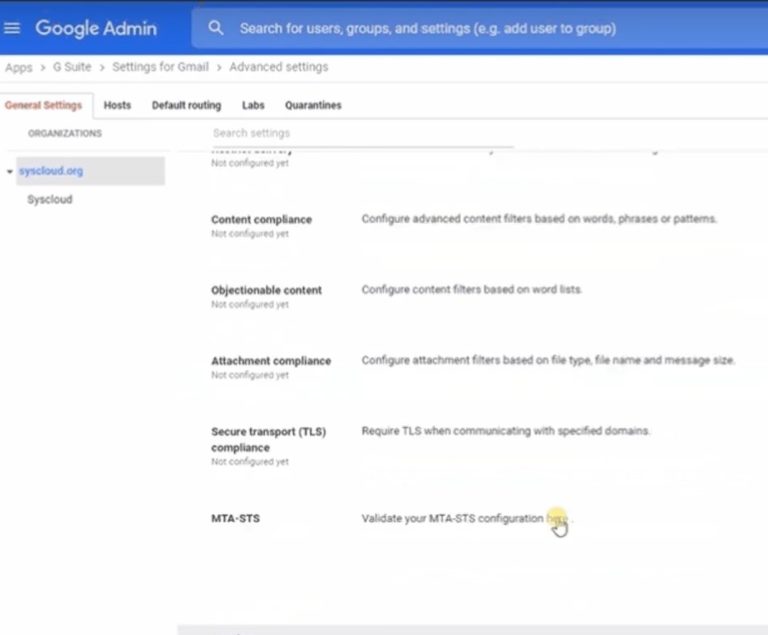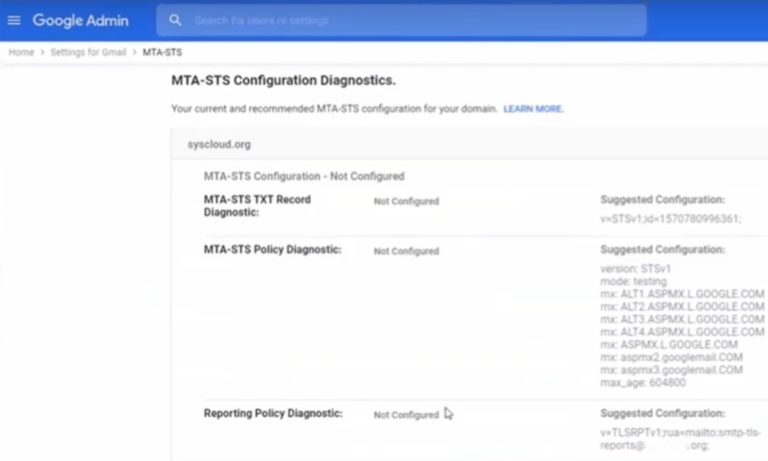- Guide
What Is MTA-STS: How (and Why) to Create a Policy
Message Transfer Agent – Strict Transport Security (MTA-STS) is an email security protocol to make incoming messages safer by requiring encryption for mail sent to a domain. It is typically used to ensure that incoming mail is encrypted via TLS 1.2 or higher.
Email might seem secure, but without MTA-STS, your messages are basically postcards that anyone on the delivery route can read.
Fortunately, MTA-STS can be easily implemented via a policy file, which you can deploy by uploading it to your domain. Don’t worry if that sounds intimdiating—we’ll show you the syntax of this command shortly.
MTA-STS can also be combined with TLS Reporting (TLSRPT) to let you receive reports of any incoming mail that was rejected for violating your MTA-STS policy. This is essential for debugging a policy. We’ll also cover setting up TLS Reporting in this article.
Before we dive in, let’s begin with a brief overview of the key terms and syntactic elements relevant to MTA-STS. The following table will serve as a reference you can refer to throughout the article.
| version | Which version of the MTA-STS specification is being used. |
| mode | Specifies whether an MTA-STS policy should be enforced, ignored, or only generate violation reports. |
| mx | Specifies which mail servers are authorized to handle mail for your domain. |
| max_age | The maximum lifetime of the MTA-STS policy, in seconds. |
| TLSRPT | A protocol for reporting messages that fail MTA-STS policy. |
What Is MTA-STS?
MTA-STS (Mail Transfer Agent Strict Transport Security) is a security standard introduced to improve email transport security. It’s designed to ensure that mail servers establish secure SMTP (Simple Mail Transfer Protocol) connections using Transport Layer Security (TLS) and to reduce the risk of man-in-the-middle attacks.
Email security has a serious blind spot that most organizations don’t even realize exists. While you’ve probably set up SPF, DKIM, and DMARC to prevent spoofing and phishing, there’s still a vulnerability in how your emails travel from one server to another: the connection itself.
The original SMTP protocol was designed without security in mind. The STARTTLS command was added in 1999 to encrypt connections, but it has two major flaws:
- It’s optional – Servers can simply ignore encryption requests
- It’s vulnerable to downgrade attacks – Attackers can strip out encryption commands, forcing messages to be sent in plain text
This means even if your server tries to send encrypted emails, a man-in-the-middle attacker can force those messages to be transmitted as plain text. And you’d never know it happened.
MTA-STS solves these problems by creating a clear security policy for your domain that:
- Requires encryption – Forces emails to use TLS encryption (version 1.2 or higher)
- Validates certificates – Ensures the receiving server has a valid certificate
- Specifies authorized servers – Lists which mail servers are allowed to receive mail for your domain
- Offers enforcement options – Lets you control what happens when secure connections fail
How Does MTA-STS Work?
Here’s a step-by-step breakdown of how MTA-STS works:
- Policy Publication:
- The domain owner (e.g.,
example.com) creates an MTA-STS policy. This policy defines the requirements for mail servers that wish to send emails to the domain. - The policy is then made available on a web server under a well-known URL, typically
https://mta-sts.example.com/.well-known/mta-sts.txt.
- The domain owner (e.g.,
- DNS Record:
- The domain owner also publishes an MTA-STS DNS TXT record in their domain’s DNS zone. This record signals to sending mail servers that the domain supports MTA-STS and where to fetch the policy.
- The DNS record might look something like this:
_mta-sts.example.com. TXT "v=STSv1; id=20220101T000000Z;", whereidis a unique identifier for the policy.
- Policy Discovery:
- When an external mail server (the sending server) wants to send an email to
example.com, it first checks for the presence of the MTA-STS DNS TXT record forexample.com. - If the record exists, the sending server fetches the MTA-STS policy from the well-known URL.
- When an external mail server (the sending server) wants to send an email to
- Policy Evaluation:
- The sending server evaluates the fetched MTA-STS policy to determine the domain’s TLS requirements.
- The policy typically specifies:
- Which MX hosts are valid for the domain (
mxfield). - The desired behavior if a secure connection cannot be established (
modefield:enforce,testing, ornone). - How long the policy should be cached (
max_agefield).
- Which MX hosts are valid for the domain (
- Connection Establishment:
- Based on the MTA-STS policy, the sending server attempts to establish a secure TLS connection to the receiving server (one of the MX hosts specified in the policy).
- If the connection meets the criteria defined in the policy (e.g., valid certificate, strong encryption), the email is transmitted securely.
- If the connection doesn’t meet the criteria and the policy mode is set to
enforce, the email will not be sent, and the sending server will typically generate a bounce message or error.
- Policy Updates:
- Domain owners can update their MTA-STS policy as needed. When they do, they should also update the
idfield in the DNS TXT record to signal to sending servers that a new policy is available. - Sending servers periodically check for updated policies based on the
max_agedirective in the current policy.
- Domain owners can update their MTA-STS policy as needed. When they do, they should also update the
- Reporting:
- Optionally, domain owners can include a
ruafield in their MTA-STS policy, specifying an email address where sending servers can send reports about connection attempts. This allows domain owners to monitor and troubleshoot any issues with their MTA-STS implementation.
- Optionally, domain owners can include a
How to Create an MTA-STS Policy
The following assumes that you have access to both inbound mail servers and web servers that support connections encrypted using TLS/SSL (the latter because the policy file is retrieved by HTTPS). The steps to make that happen are outside the scope of this post.
Let’s examine a real MTA-STS policy. After making it, we can go through the parts and examine why the policy writers did things a certain way as well as what configurations you may want to change depending on your needs.
1. Writing the Policy File
With the prerequisite DNS and file system obstacles overcome, we can finally begin focusing on the content of the policy file itself. A policy consists of four kinds of directives: version, mode, mx, and max_age. Let’s go through them one by one so you can more easily figure out what values would work for your setup.
2. version
This one’s easy: STSv1 is the only version of the MTA-STS protocol in existence, so you’ll have to use that.
3. mode
What should happen to mail that fails to comply with your MTA-STS policy? If we set this to enforce, then sending servers that support MTA-STS will fail to deliver mail to your domain if your MX hosts don’t match those in your policy file, or the MX hosts fail certificate validation, or they do not support STARTTLS. Additionally, if the sending server supports sending reports, a TLS Report will be sent if you have TLSRPT set up (we’ll cover that soon). If set to testing, then mail will still be delivered even if encryption fails, but a TLSRPT will still be sent if possible, and if set to none, the sending server will act as though no policy were in place.
4. mx
For each MX host associated with your domain, you must have a separate mx directive pointing to that MX host. It’s paramount that each MX server has a valid TLS certificate for the sender to encrypt the content with.
5. max_age
The max_age directive defines how long servers should cache your policy before checking for a new one. Google will only process policies with a max_age higher than 86400 seconds (equal to one day). Because of this, 86400 is the most popular value, and it’s what we recommend as well.
|
Platform
|
Success Rate
|
Success Rate Frame
|
Estimated FTEs
|
Maintenance
|
Marketplace Apps Identified
|
|---|---|---|---|---|---|
|
DIY Manual
|
20%
|
12+ Months
|
2-3
|
Never ending
|
~100 services
|
|
Outsourced Manual
|
<40%
|
9-12 Months
|
1-2
|
Never ending
|
~100 services
|
|
Valimail Automation
|
97.8%
|
0-4 Months
|
0.2
|
Automated
|
6,500+
|
Setting up DNS
For this example, we will use Google, along with Unix command-line tools instead of screenshots, because their results are easier to reproduce, independently verify, and adapt to your needs.
$ curl https://mta-sts.google.com/.well-known/mta-sts.txt
version: STSv1
mode: enforce
mx: smtp.google.com
mx: aspmx.l.google.com
mx: *.aspmx.l.google.com
max_age: 86400First, we see that the policy file is accessed via the mta-sts.google.com subdomain. Second, we see that the policy file itself is hosted at the path /.well-known/mta-sts.txt. Neither of these facts is arbitrary—rather, that subdomain and path are the required locations for an MTA-STS policy file. Therefore, to create your own policy, you will need to create this file at that same location on your own domain.
One final point before we begin picking apart the actual contents of the policy file: To officially enable MTA-STS and thus communicate to SMTP servers that incoming mail should comply with the policy, you must add a special DNS record at the subdomain _mts-sta (note the leading underscore). Let’s see what this looks like in practice, using Google as a model once again:
$ dig -t txt +noall +answer _mta-sts.google.com
_mta-sts.google.com. 213 IN TXT "v=STSv1;id=20210803T010101;"It’s mandatory for there to be a TXT record, which is the kind of record we see above. The v=STSv1 part means we are using version one of the MTA-STS protocol, which to date is the only version. The ID is an arbitrary combination of 1-32 alphanumeric characters. You can set it to whatever you want within that limit. If you ever change your policy, you can change this ID string to let other servers know that your policy has been updated. So how do you decide what to set it to? Google’s Workspace Admin Support offers some solid advice:
Update the id to a new, unique value every time you change your MTA-STS policy. […] We recommend using the current date and time for the id value so you know when your policy last changed.
Source: https://support.google.com/a/answer/9276512, “Add DNS TXT records“
This tactic is similar to that of creating the serial number in the SOA record for a zone, as experienced DNS administrators may recognize.
Armed with an understanding of the directives that make up an MTA-STS Policy, you can leverage your new knowledge to combine these elements into a real policy file. Let’s say you want to deploy an enforced policy with a max_age of 86400 seconds and your domain has three MX servers: mx1.domain.com, mx2.domain.com, and mx3.domain.com. The policy file would look like this:
version: STSv1
mode: enforce
mx: mx1.domain.com
mx: mx2.domain.com
mx: mx3.domain.com
max_age: 86400That’s it! Not so intimidating, once you understand the various parts.
Adding Reporting with TLSRPT
Because MTA-STS leads to the rejection of certain non-compliant mail, there’s a possibility that a misconfigured policy could lead to legitimate mail not being properly delivered. To mitigate this risk and aid in debugging mail problems caused by MTA-STS, admins have the option of setting up reporting that lets SMTP servers send a report on successful and rejected TLS connections to a predetermined email address, where these reports can be consumed and monitored for signs of issues.
To enable such reports, we apply a standard known as SMTP TLS Reporting (commonly abbreviated as TLSRPT). Implementing TLSRPT is as simple as adding another TXT record to your DNS zone file, this time to the _smtp._tls subdomain. To demonstrate, we will again use Google as our exemplar:
$ dig -t txt +short _smtp._tls.google.com
"v=TLSRPTv1;rua=mailto:sts-reports@google.com"Just like with the MTA-STS TXT record, we start with a version number. As before, only one version has been promulgated, so v=TLSRPTv1 is the only value you’ll find this set to (but it’s still important to set it this way to clarify what version you’re using, in case a new version with incompatible features comes out in the future). The second part, rua (Aggregate Reporting URI), dictates how you can be contacted with aggregate reports of TLS connection successes (or failures!).
Reports can be delivered by one of two methods – SMTP or HTTP POST – and the rua tag in your MTA-STS record will include the appropriate URI to reflect your preference – e.g., rua=mailto:reports@example.com or rua=https://reporting.example.com/v1/tlsrpt
Note that reports send to this address must be DKIM-signed, per RFC 8460 Section 3.
What a Report Looks Like
Now that you know how to set up reporting, let’s get a closer look at what these reports actually consist of. The sending server will usually provide a daily, aggregate report containing data about messages they’ve sent you in the form of a GZIP compressed JSON file. The file itself will contain data formatted similarly to the following:
{
"organization-name": "Some other company",
"date-range": {
"start-datetime": "2022-01-01T00:00:00Z",
"end-datetime": "2022-01-22T23:59:59Z"
},
"contact-info": "sts-reporting@some_other_company.test",
"report-id": "5034327c-44d3-47da-b6a0-946ea4e8c4be",
"policies": [{
"policy": {
"policy-type": "sts",
"policy-string": ["version: STSv1","mode: testing",
"mx: *.mail.yourdomain.example","max_age: 86400"],
"policy-domain": "yourdomain.example",
"mx-host": "*.mail.yourdomain.example"
},
"summary": {
"total-successful-session-count": 2323,
"total-failure-session-count": 203
},
"failure-details": [{
"result-type": "certificate-expired",
"sending-mta-ip": "2001:db8:abdd:0015::5",
"receiving-mx-hostname": "mx1.mail.yourdomain.example",
"failed-session-count": 34
}, {
"result-type": "starttls-not-supported",
"sending-mta-ip": "2001:db8:abcd:0013::1",
"receiving-mx-hostname": "mx2.mail.yourdomain.example",
"receiving-ip": "203.0.113.57",
"failed-session-count": 200,
"additional-information": "https://reports.yourdomain.example/
report_info ? id = 5065427 c - 23 d3# StarttlsNotSupported "
}]
}]
}The core of the summary resides in the policies section, where we see a breakdown of the MTA-STS policy as the reporting server interprets it, a summary of basic statistics on delivered emails and failures, and finally an array of specific failures with statistics and details.
The precise schema for this JSON file is defined in RFC 8460 Section 4.4, although the report itself does a decent job of explaining itself. When unsure, look at two fields, “result-type” and “additional-information”, as these fields serve to explain the nature of a failure. Detailed explanations of the meaning of different values that can appear in the Result Types can be found in RFC 8460 Section 4.3.
That’s all there is to it! However, sometimes a theoretical understanding isn’t sufficient. Let’s take it to the next level by implementing a real MTA-STS policy on a live domain, with reporting.
MTA-STS with Google Workspace
Workspace makes creating an MTA-STS policy trivially easy. First, browse to your Google Admin console. Then open Apps -> G Suite -> Gmail -> Advanced settings. Navigate down to the compliance section and look for MTA-STS.

Click on it to be presented with the exact recommended MTA-STS configuration for your setup:

Voila, Workspace has just created and configured the policy you need, which you can deploy using the steps above.
Avoiding Common Pitfalls
Before you begin implementing your own MTA-STS policy, it’s best to apply some best practices that have been developed based on the experiences of the email administration community. Here are some quick tips that will save you headaches down the road:
- Set mode to testing and verify before setting to enforce.
- Don’t set max_age too large or changes will delay propagation.
- If you already enforce TLS with DANE, you still can and should use MTA-STS.
That last point requires some explanation. MTA-STS is an alternative to DANE that is easier to implement because DANE requires DNSSEC.

Minimal resource requirement with only a single one time DNS change needed

DMARC Enforcement guarantee and 97.8%+ success rate

100% Automated service discovery and 1-click validation
Implement Your MTA-STS Policy
MTA-STS policy file syntax is simple, but there are many areas of the implementation that sysadmins can get wrong. DNS, file hosting, and mail server administration are all murky technical fields mired in complicated technical stacks. Left to figure everything out by trial and error, adding new features like MTA-STS is no walk in the park, and debugging can be even harder.
The guidance in this article was thoroughly tested for correctness at every step, so your MTA-STS implementation experience will be easy and smooth. By astutely avoiding the pitfalls, adhering to best practices, and following the advice that we laid out above, you should be able to create a secure, robust MTA-STS policy and thereby make your organization a little more secure.
Explore the chapters:
- 1. Introduction – Email Security Best Practices
- 2. MTA-STS
- 3. DKIM Selector
- 4. DMARC vs DKIM
- 5. DMARC Office 365
- 6. SPF Failure
- 7. SPF Softfail vs Hardfail
- 8. What Helps Protect from Phishing
- 9. Fixing the Error “No DMARC Record Found”
- 10. DKIM Office 365
- 11. How to Configure DMARC Policy to Reject or Quarantine
Get started for free
with Monitor
Start your path to DMARC enforcement with a panoramic view of the traffic being sent on your behalf.
No trial offers, credit cards, or obligations.
Explore all Valimail
has to offer
Go one step further than visibility…Take action! Reach DMARC enforcement faster. Stay compliant with evolving sender requirements. All while protecting your brand.